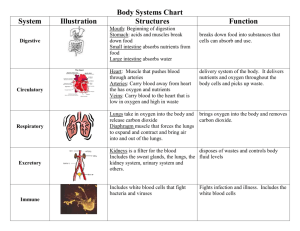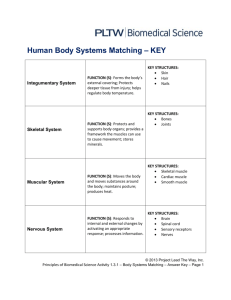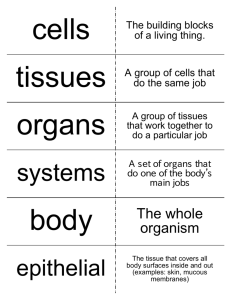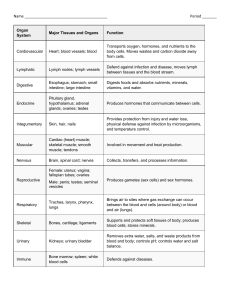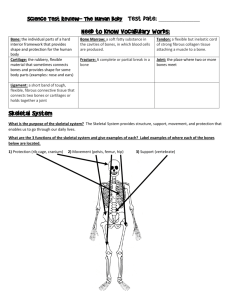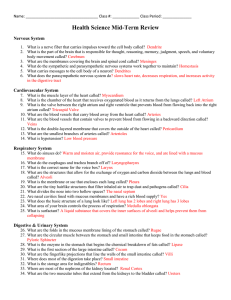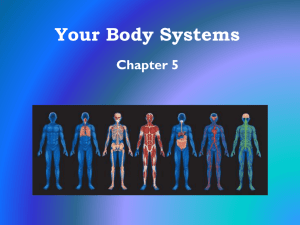Body Systems Ch. 8-12
advertisement
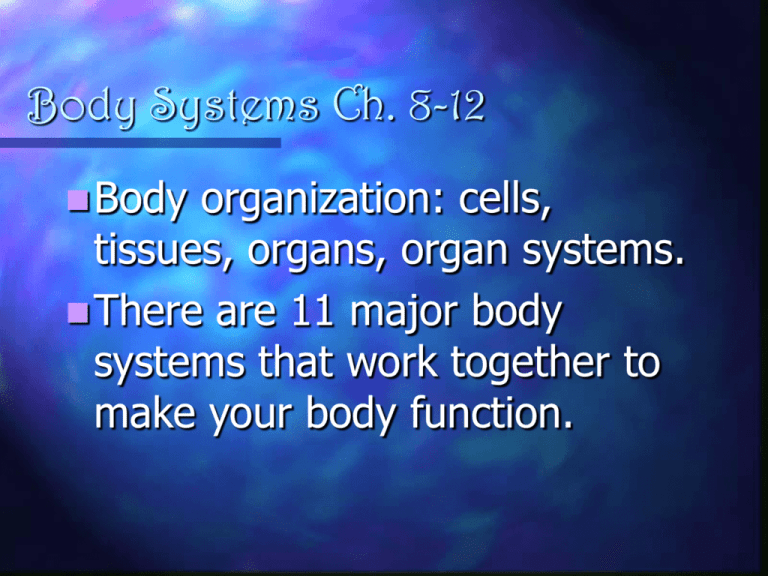
Body Systems Ch. 8-12 Body organization: cells, tissues, organs, organ systems. There are 11 major body systems that work together to make your body function. Skeletal System Bones, cartilage and connective tissue Approx. 206 bones Compact bone-has no visible open spaces; rigid, dense; outer layer Spongy bone-has many open spaces; provides strength and support; the second layer Marrow-soft tissue; red produces blood cells; yellow stores fat Joints-three types-gliding (wrist); ball-and-socket (shoulder); hinge (knee) Muscular System Smooth muscle; involuntary; digestive system Cardiac muscle; involuntary; only in your heart Skeletal muscle; voluntary and involuntary; attached to bones by tendons; work in pairs; muscles that straighten-extensor (triceps); that bendflexor (biceps) Integumentary System Protects, covers and maintains homeostasis Includes hair, skin, and nails Two layers of skin: epidermis and dermis Cardiovascular System Heart, blood, blood vessels Maintains homeostasis (carries nutrients and removes waste) Heart-cardiac tissue; about the size of your fist. Mammalian hearts have four chambers-2 atria (top) and 2 ventricles (bottom); valves between chambers and the major arteries Continued Blood vessels-arteries, veins, capillaries Arteries carry blood away from the heart; have a layer of smooth muscle which also pump with the heart Capillaries allow exchange of nutrients and wastes between the blood and cells Veins carry the blood to the heart; valves in them prevent backward bloodflow. Lymphatic System Fights pathogens (germs) and collects excess fluids Carries fluids in lymphatic vessels throughout your body Lymph nodes-thoughout the body, filter lymph (fluid) and remove dead cells and pathogens from the body; this is why they swell when you have an infection! Thymus, tonsils and spleen are other parts of the system. Digestive System Breaks down food Food passes through mouth, esophagus, stomach, small intestine, large intestine, rectum Part of system but food doesn’t go through:teeth, gallbladder, liver, pancreas Teeth and saliva begin breaking down food mechanically and chemically. Esophagus pushes food down by peristalsis (sm. Muscle movement) Stomach churns and uses acid and enzymes to break down food. Small intestine is covered with villi, which absorb the nutrients into the blood. Liver produces bile which is stored in the gallbladder, which is secreted into the sm. Int. to break down fats. Large intestine absorbs leftover water back into the body. Urinary System Removes waste products from the blood. Kidneys filter the blood to remove wastes and water. Nervous System Divided into two: Central Nervous System (brain, spinal cord) and Peripheral Nervous System (all other parts) Gathers and interprets information from the environment and your body. Sends signals to your body. Endocrine System Controls the body’s functions through hormones (chemicals). Hormones include epinephrine (adrenaline), thyroid hormone, estrogen, testosterone, insulin. Glands secrete hormones: pituitary, thyroid, adrenals, pancreas, ovaries and testes. Reproduction Sexual reproduction involves the union of two gametes (egg and sperm). External fertilization takes place outside the female’s body. Frogs, many fish, use ext. fertilization. Internal fertilization takes place inside the female’s body. Mammals Mammals produce milk for their young. There are three types: Monotremes: lay eggs; platypus Marsupial: give birth to partially developed young that continue to develop in a pouch. Opossum, koala Placentals: give birth to a more developed newborn than marsupials; nourished inside the mother’s body. Placentals/Humans Words to know: Umbilical Cord-connects the fetus (baby) to the placenta; contains large blood vessels Placenta-structure that forms on the wall of the uterus that allows for the exchange of nutrients between fetus and mother In males, sperm are produced by the testes, which also produce testosterone. In females, eggs are produced by the ovaries and released usually once every 21-40 days during the menstrual cycle. Menstrual Cycle-starts at puberty and continues through the 40s or 50s; prepares the body for pregnancy; an egg matures, is released, then if not fertilized, is shed with the uterine lining in a process called menstruation. This bleeding lasts about 5 days (3-8). The cycle then starts over. Development IF the egg is fertilized, the egg is now called a zygote. Once it divides, it’s called an embryo. The embryo will move down the fallopian tube into the uterus (fig. 1 p. 318) where it may implant into the uterine lining. Timeline-p. 321

